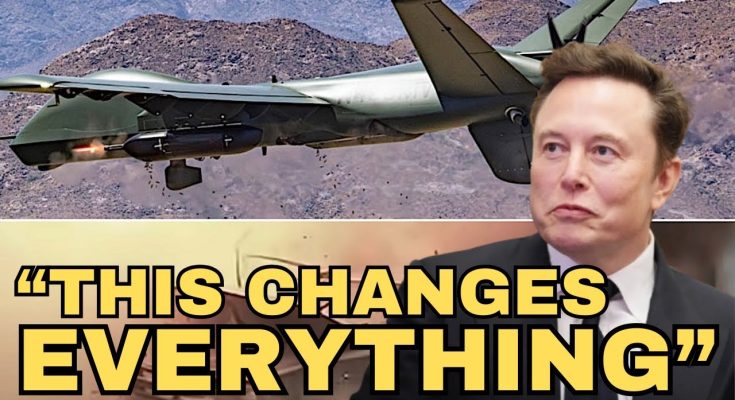Elon Musk’s prediction that a new U.S. Air Force drone will “disrupt everything” has generated massive excitement and speculation in both the aerospace and defense sectors. Musk, known for his bold statements and visionary thinking, is referring to the Skyborg program—a cutting-edge initiative that’s poised to revolutionize the future of air warfare. The Skyborg drone, developed as part of the U.S. Air Force’s artificial intelligence (AI) and unmanned aerial vehicle (UAV) technologies, is expected to reshape the very nature of combat, leveraging automation, autonomy, and advanced capabilities to provide a strategic edge in modern conflicts.
The Rise of Skyborg: A Game-Changer in UAVs
Skyborg is a part of the U.S. Air Force’s effort to create a new class of “loyal wingman” drones. These autonomous, AI-powered aircraft are designed to operate alongside manned fighters, providing critical support in missions such as surveillance, electronic warfare, and even direct combat. Unlike traditional drones that are manually controlled, Skyborg can make independent decisions on the battlefield, reacting to threats and adjusting its tactics in real time. This level of autonomy, powered by sophisticated AI, is a key factor that has captured the attention of Musk and other tech visionaries.
Skyborg drones are designed to be flexible and adaptable, meaning they can be equipped with various payloads for different types of missions. They will integrate seamlessly with existing fighter aircraft, such as the F-35 or F-22 Raptors, and function as an extension of the pilots’ capabilities. This makes Skyborg not only a formidable fighter in its own right but also a valuable force multiplier, allowing human pilots to focus on higher-level strategic decisions while the drones handle more routine or dangerous tasks.
Disruptive Technology: AI, Autonomy, and Cost-Efficiency
Musk’s statement about Skyborg disrupting everything revolves around its combination of cutting-edge AI and autonomous flight systems. These technologies enable Skyborg drones to perform tasks traditionally handled by human pilots, but with far greater precision, endurance, and speed. The AI algorithms powering the drones allow them to learn from each mission, improving their performance over time and adapting to different combat scenarios.
Skyborg drones also represent a major leap in terms of cost-efficiency. Traditional fighter aircraft are expensive to build, maintain, and operate. In contrast, autonomous drones like Skyborg are expected to be far cheaper to produce and deploy. This cost reduction makes it feasible for the Air Force to use a larger number of drones in various operations, overwhelming adversaries with sheer numbers and capabilities. A fleet of Skyborg drones can be launched at a fraction of the cost of deploying manned aircraft, giving the U.S. a significant strategic advantage.
Human-Machine Collaboration: The “Loyal Wingman” Concept
One of the key elements of the Skyborg program is its “loyal wingman” concept, where drones operate alongside human pilots as part of a team. These drones aren’t designed to replace human pilots; instead, they complement them, working in tandem to enhance operational effectiveness. This collaboration allows pilots to focus on complex decision-making and high-level tactics, while the drones handle more routine tasks like patrolling, reconnaissance, and suppressing enemy air defenses.
This partnership between manned and unmanned aircraft also brings the benefit of reducing the risk to human life in high-risk combat situations. The drones can take on the dangerous roles of penetrating enemy airspace, drawing fire, or engaging in electronic warfare, while the manned aircraft can stay out of harm’s way or focus on precision strikes.
The Future of Warfare
Elon Musk’s enthusiasm about Skyborg comes from the enormous potential it holds in changing the future of warfare. With drones capable of operating autonomously, the battlefield will look entirely different. AI-driven drones will be able to process vast amounts of data, predict enemy movements, and react faster than human pilots ever could. The use of autonomous systems will also reduce the number of human errors in combat, making military operations more precise and efficient.
Moreover, Skyborg represents a shift toward asymmetrical warfare. By deploying a large fleet of cost-effective, autonomous drones alongside smaller numbers of manned aircraft, the U.S. Air Force will be able to outmaneuver and outlast adversaries. The sheer volume of data these drones can collect and analyze also opens new possibilities for surveillance and intelligence gathering, which could shift the balance of power in future conflicts.
Conclusion
Elon Musk’s comment about the U.S. Air Force’s Skyborg drone program highlights the disruptive nature of this technology. By combining artificial intelligence, autonomy, and cost-effectiveness, Skyborg drones will change how the military conducts operations in the air. Their potential to enhance the capabilities of human pilots, reduce costs, and redefine warfare strategies positions them to be a game-changer in modern conflict. As this program moves closer to full deployment, it will undoubtedly shape the future of air combat, offering a glimpse into a new era of autonomous military technology. Musk’s prediction may very well become a reality—Skyborg is poised to truly disrupt everything.



